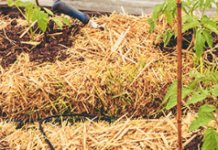Boost this year’s harvest and reduce pest problems with less effort, while being kind to the environment. Employ row covers, chicken wire cloches and crop cages to prevent damage without the aid of chemicals.
Floating row covers of spun-bonded or woven materials let air, light, and water through to the covered plantings. The warm air that is captured protects the plantings from frosty temperatures. The coverings also prevent birds from dining on newly planted seeds and eliminate damage by certain insects like flea beetles, onion maggots, seed corn maggots, and leafhoppers that may infect lettuce, celery, and carrots with aster yellows disease.
Cover susceptible seeds and transplants at planting to prevent the insects from reaching the plants. Insects like flea beetles and onion and seed corn maggots overwinter as adults in the soil near the previous season’s planting. Move susceptible plants to a different part of the garden to avoid trapping the insects under the row cover with their favorite food source.
Double the benefit with less effort by planting short season radishes with long season cole crops such as cabbage, broccoli, and cauliflow er. Harvest the radishes as the larger vegetable plants need the space. This will provide two harvests from one row. The row cover eliminates problems with root maggots on radishes, cabbage worms on cole crops, and rabbits from dining on them all.
Basil and beans are favorites of Japanese beetles. Cover these at planting and since they do not need pollination to enjoy the harvest, leave the fabric in place throughout the season. Just lift to harvest and replace.
Cover squash at planting to prevent birds from dining on newly planted seeds and to reduce the risk of squash vine borer and squash bugs. The fabric prevents these insects from accessing the plants. Remove the covers when flowering begins to allow pollinators access to the blossoms. Don’t use row covers when planting squash in the same location as the previous year. Since squash vine borer insects will overwinter in the soil near the squash plants, the row cover will trap the insects and provide easy access to the plants. Continue to monitor for these pests throughout the remainder of the season.
Loosely drape the row cover fabric over the planting and secure the edges with boards, pipes, stones, or landscape pins. Commercial setups like the 3-Season Plant Protection Tent include a framework and fabric covers, making it easy for gardeners to cover and access the plantings. Systems like this include two covers; one to protect plants from cold and a second lighter weight fabric for preventing insect damage during the warmer growing season. Reuse the fabrics as long as they remain intact.
Self-supporting mesh enclosures like Pest Control Pop-Ups (gardeners.com) are another option for protecting plantings from insects, birds, and animals. Look for products like this that are simple to install and fold flat for easy storage when not in use. Finer mesh products keep out insect pests while larger mesh wire covers protect plantings from birds and animals, including hungry squirrels dining on greens and ripe tomatoes. Various sizes and designs provide coverage for individual plants, raised beds and berry bushes. Make this the year to be proactive at preventing and minimizing pest damage throughout season without the use of chemicals. Your efforts will be rewarded with a bountiful harvest.




